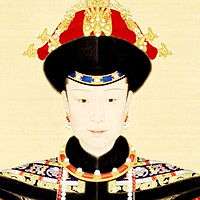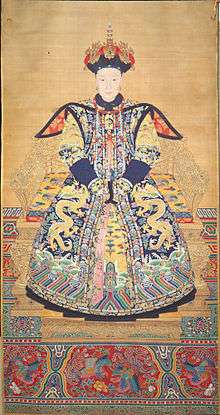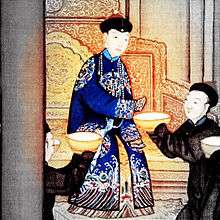Empress Xiaoxianchun
| Empress Xiaoxianchun | |||||
|---|---|---|---|---|---|
 | |||||
| Empress of the Qing dynasty | |||||
| Tenure | 1737–1748 | ||||
| Predecessor | Empress Xiaoshengxian | ||||
| Successor | Ulanara, the Step Empress | ||||
| Born | 28 March 1712 | ||||
| Died | 8 April 1748 (aged 36) | ||||
| Burial | Yuling Mausoleum, Eastern Qing tombs, China | ||||
| Spouse | Qianlong Emperor | ||||
| Issue |
unnamed daughter Yonglian Gurun Princess Hejing Yongcong | ||||
| |||||
| Father | Lirongbao | ||||
| Empress Xiaoxianchun | |||||||
| Chinese name | |||||||
|---|---|---|---|---|---|---|---|
| Traditional Chinese | 孝賢純皇后 | ||||||
| Simplified Chinese | 孝贤纯皇后 | ||||||
| |||||||
| Lady Fuca | |||||||
| Chinese | 富察氏 | ||||||
| |||||||
| Manchu name | |||||||
| Manchu script | ᡥᡳᠶᠣᠣᡧᡠᠩᡤᠠ ᡝᡵᡩᡝᠮᡠᠩᡤᡝ ᠶᠣᠩᡴᡳᠶᠠᠩᡤᠠ ᡥᡡᠸᠠᠩᡥᡝᠣ | ||||||
| Romanization | hiyoošungga erdemungge yongkiyangga hūwangheo | ||||||

Empress Xiaoxianchun (28 March 1712 – 8 April 1748) was the first Empress Consort of the Qianlong Emperor of the Qing dynasty.
Family background
Empress Xiaoxianchun was born in the Manchu Fuca (富察) clan, which was under the Bordered Yellow Banner. Her personal name is not recorded in history.
Lady Fuca's great-grandfather, Hashitun (哈什屯; 1589–1663), served as a member of the Vanguards under Nurhaci, the founder of the Qing dynasty, and later joined the Imperial Guards. He served the Shunzhi Emperor after 1650 and was awarded the title of a baron. Her grandfather, Misihan (米思翰; 1632–1675), served as a minister of the Imperial Household Department in the early reign of the Kangxi Emperor. He was also Secretary of the Ministry of Revenue and a member of the Deliberative Council of Princes and Ministers. Her father, Lirongbao (李榮保; died 1723), was the Supervisor of Chahar Province, and was posthumously granted the title of a first class duke when his daughter became Empress in 1737. Lady Fuca had three uncles – Masika (馬斯喀; died 1704), Maqi (馬齊; 1652–1739), and Mawu (馬武; died 1726) – who served in high-ranking positions in the Qing government during the reign of the Kangxi and Yongzheng Emperors.
Lady Fuca had seven elder brothers, two younger brothers, and several sisters. Among her siblings, the most notable one was Fuheng (1715–1770), who was the commander of the Qing forces in the Sino-Burmese War in 1769.
Marriage to the Qianlong Emperor
In 1727, Lady Fuca married Hongli (Prince Bao), the fourth son of the Yongzheng Emperor, and became his primary consort (嫡妃). She then moved into the Palace of Eternal Spring in the western part of the Forbidden City.
In 1735, the Yongzheng Emperor died and was succeeded by Prince Bao, who was enthroned as the Qianlong Emperor. Two years after her husband's coronation, Lady Fuca, as the emperor's primary consort, was instated as Empress.
As Empress

In the Draft History of Qing, Lady Fuca is described as a respected and virtuous person. She looked after the Qianlong Emperor and the people in the palace, and served her role as Empress well. She was praised and favoured by the emperor.[1] It is also said that Lady Fuca did not like spending money for her own good. Instead of wearing jewellery, she would wear wild flowers in her hair.
The Qianlong Emperor once told her a story that Manchus were too poor to make their own pouches from cloth and had to settle for simple deer hide instead. She immediately made one for him. He was touched by the gift. Lady Fuca also made other pouches for him.[2]
Lady Fuca took her duties seriously when it came to Confucian rituals. As head of the women's quarters in the palace, she supervised the emperor's consorts when performing a ritual. One of these was a rite concerning sericulture that was presided over by the Empress. This rite, which had been practised since the Zhou dynasty, was gradually restored during the reign of the Qianlong Emperor. For the purpose of this rite, a sericulture altar was constructed in 1742.
In 1744, a new Altar to Sericulture was completed,[3] largely at Lady Fuca's urging.[4] In the same year, Lady Fuca became the first empress in the Qing dynasty to personally lead the women in the palace in these rites. They made offerings of mulberry and presented them to silkworm cocoons, all of them working industriously.
The whole rite was painted on four scrolls in 1751 in memory of Lady Fuca, who died in 1748.[5]
Death
Lady Fuca often joined the Qianlong Emperor on his excursions throughout China. In 1748, during one of the Qianlong Emperor's southern tours, Lady Fuca became seriously ill and eventually died on 8 April at the age of 36. She was interred in the Yuling Mausoleum in the Eastern Qing tombs. It is said that the Qianlong Emperor often visited her grave with wistful longing, and remained heartbroken to the end of his days.
Children
Lady Fuca bore the Qianlong Emperor two sons and two daughters, of whom only one daughter survived to adulthood.[6]
Her first daughter, who was also the Qianlong Emperor's first daughter, was born in 1728 and died within the same year. Her second daughter, known by her title "Gurun Princess Hejing" (固倫和敬公主; 1731–1792), was the Qianlong Emperor's third daughter.
Her first son, Yonglian (永璉; 1730–1738), was the Qianlong Emperor's second son. He died before reaching adulthood and was posthumously honoured as "Crown Prince Duanhui" (端慧皇太子). Her second son, Yongcong (永琮; 1746–1747), was the Qianlong Emperor's seventh son. Like Yonglian before him, he also died before reaching adulthood and was posthumously honoured as "Prince Zhe of the First Rank" (哲親王).
See also
Notes
References
- Ho, Chuimei; Bronson, Bennet (2004). Splendors of China's Forbidden City: The Glorious Reign of Emperor Qianlong (Illustrated ed.). Merrell. ISBN 1858942039.
- Kutcher, Norman (August 1997). "The Death of the Xiaoxian Empress: Bureaucratic Betrayals and the Crises of Eighteenth-Century Chinese Rule". The Journal of Asian Studies. 56 (3): 708–725.
- Naquin, Susan (2000). Peking: Temples and City Life, 1400–1900. University of California Press.
- Wan, Yi; Shuqing, Wang; Yanzhen, Lu; Scott, Rosemary E. (1988). Daily Life in the Forbidden City: The Qing Dynasty, 1644-1912 (Illustrated ed.). Viking. ISBN 0670811645.
- Zhao, Erxun (1928). Draft History of Qing (Qing Shi Gao) (in Chinese).
| Chinese royalty | ||
|---|---|---|
| Preceded by Empress Xiaoshengxian (Empress Xiaojingxian was the actual predecessor) |
Empress of China 1738 – 8 April 1748 |
Succeeded by Ulanara, the Step Empress |